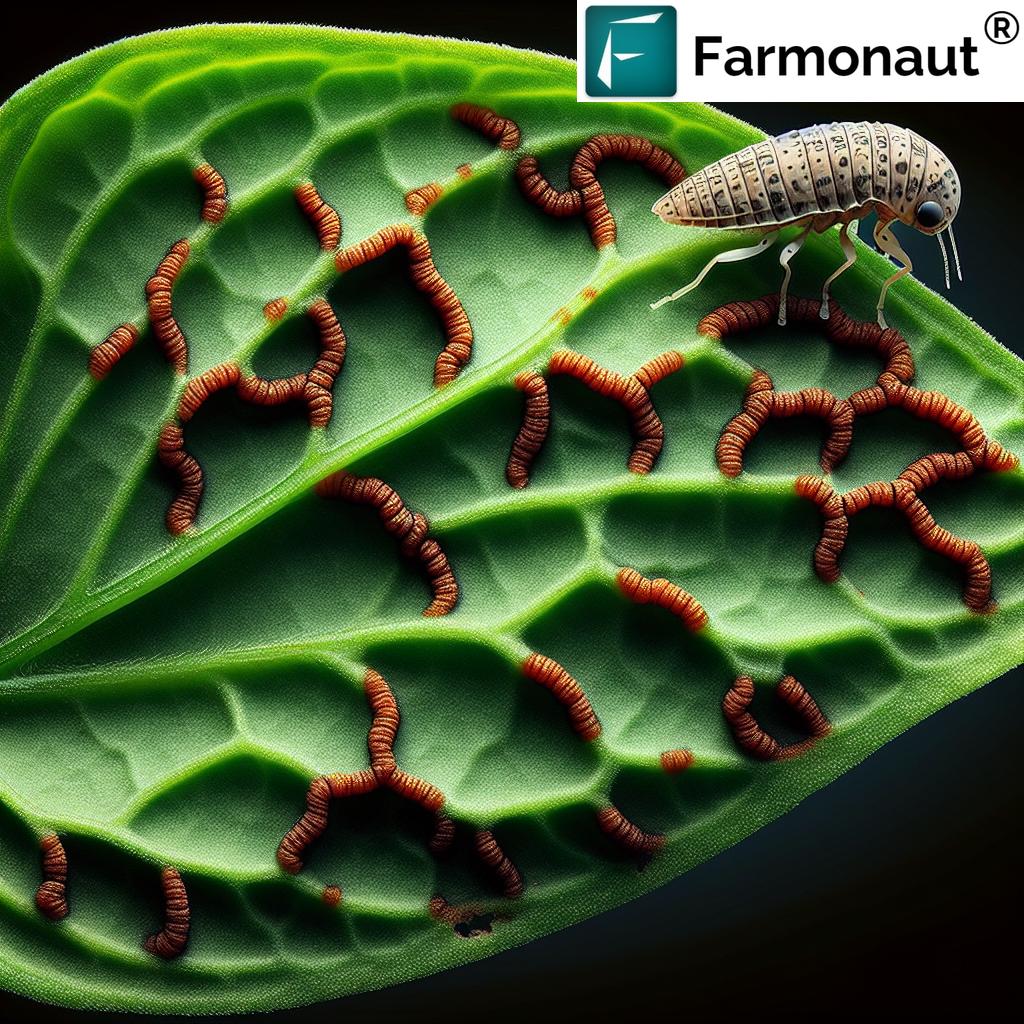Scirtothrips dorsalis: Understanding and Managing this Elusive Pest

In the world of agriculture and horticulture, pests pose a constant threat to crop health and productivity. Among these, Scirtothrips dorsalis, commonly known as chilli thrips or tea thrips, has emerged as a particularly challenging adversary. This tiny yet formidable insect has become a significant concern for farmers and gardeners alike, affecting a wide range of plants across various regions. In this comprehensive guide, we’ll delve into the intricacies of Scirtothrips dorsalis, exploring its characteristics, impact, and most importantly, effective control strategies.
Understanding Scirtothrips dorsalis
Scirtothrips dorsalis is a species of thrips, a group of minute insects belonging to the order Thysanoptera. These pests are known for their elusive nature and fast-maneuvering capabilities, making them particularly difficult to detect and control. Let’s break down the key aspects of this pest:
Scientific Classification and Common Names
- Scientific Name: Scirtothrips dorsalis Hood
- Common Names: Chilli thrips, tea thrips, yellow tea thrips
- Order: Thysanoptera
- Family: Thripidae
Physical Characteristics
Scirtothrips dorsalis is remarkably small, typically measuring only 1-1.2 mm in length. This minute size contributes to their elusive nature, making them challenging to spot with the naked eye. Key physical features include:
- Pale yellow to brown coloration
- Elongated, slender body
- Fringed wings
- Asymmetrical mouthparts adapted for rasping and sucking plant tissues
Life Cycle
Understanding the life cycle of Scirtothrips dorsalis is crucial for implementing effective control measures. The pest undergoes incomplete metamorphosis, consisting of the following stages:
- Egg: Females lay eggs within plant tissues, often in young, tender leaves or stems.
- Larva: Two larval stages feed actively on plant tissues.
- Pupa: Non-feeding stages that typically occur in soil or leaf litter.
- Adult: Winged adults emerge and continue feeding and reproducing.
The entire life cycle can be completed in as little as 15 days under optimal conditions, allowing for rapid population growth and multiple generations per year.
Host Range and Economic Importance
One of the most concerning aspects of Scirtothrips dorsalis is its polyphagous nature, meaning it can feed on a wide variety of plant species. This broad host range makes it an economically important pest across multiple agricultural and horticultural sectors.
Potential Host Plants
Scirtothrips dorsalis has been reported to infest over 100 plant species across 40 families. Some of the most significant host plants include:
- Vegetables: Peppers, tomatoes, eggplants
- Fruits: Citrus, mango, blueberry, grapes
- Field Crops: Cotton, peanuts, soybeans
- Ornamentals: Roses, chrysanthemums, viburnums
- Other Economically Important Crops: Tea, coffee
Economic Impact
The economic importance of Scirtothrips dorsalis cannot be overstated. Its ability to rapidly reproduce and spread, combined with its wide host range, makes it a significant threat to agricultural production. Some key points regarding its economic impact include:
- Crop Yield Reduction: Heavy infestations can lead to substantial yield losses, sometimes exceeding 50% in severely affected crops.
- Quality Degradation: Damage to fruits and vegetables can render them unmarketable, particularly in high-value crops like citrus and peppers.
- Increased Production Costs: The need for intensive pest management strategies increases overall production costs for farmers.
- Trade Restrictions: Some countries have implemented quarantine measures against Scirtothrips dorsalis, potentially affecting international trade in agricultural products.
Symptoms and Damage

Recognizing the symptoms of Scirtothrips dorsalis infestation is crucial for early detection and timely intervention. These pests primarily feed on actively growing tissues, causing distinctive damage patterns:
Foliar Symptoms
- Upward Curling: Infested leaves often curl upwards, giving them a distorted appearance.
- Bronzing: Feeding damage can cause a bronze or silvery appearance on leaf surfaces.
- Scarring: Brown scarring may occur on leaves, stems, and fruits.
- Stunted Growth: Severe infestations can lead to stunted plant growth and reduced vigor.
Fruit and Flower Damage
- Scarring: Feeding on developing fruits can cause scarring and deformities.
- Color Changes: Affected areas may show discoloration or silvery patches.
- Premature Drop: Severe damage can lead to premature fruit drop or flower abortion.
Overall Plant Health
- Reduced Photosynthesis: Damage to leaves can reduce the plant’s ability to photosynthesize effectively.
- Weakened Structure: Continuous feeding can weaken the overall plant structure, making it more susceptible to other stresses.
- Yield Reduction: The cumulative effect of feeding damage often results in significant yield reductions.
Control Strategies for Scirtothrips dorsalis
Managing Scirtothrips dorsalis requires an integrated approach, combining various control methods to achieve effective and sustainable pest management. Here, we’ll explore both organic and conventional control strategies:
Organic Control Methods
For those seeking environmentally friendly options or managing organic crops, several organic control methods can be effective against Scirtothrips dorsalis:
- Cultural Control:
- Crop Rotation: Rotate susceptible crops with non-host plants to break the pest cycle.
- Sanitation: Remove and destroy infested plant material to reduce pest populations.
- Proper Irrigation: Maintain adequate soil moisture to promote plant health and resilience.
- Companion Planting: Intercrop with plants that repel thrips or attract beneficial insects.
- Physical Control:
- Reflective Mulches: Use reflective mulches to disorient and repel thrips.
- Sticky Traps: Deploy blue or yellow sticky traps to monitor and reduce adult populations.
- Protective Screens: Use fine mesh screens in greenhouses to exclude thrips.
- Biological Control:
- Predatory Mites: Release predatory mites like Amblyseius swirskii or Neoseiulus cucumeris.
- Predatory Bugs: Encourage populations of minute pirate bugs (Orius spp.) and lacewings.
- Entomopathogenic Fungi: Apply Beauveria bassiana or Metarhizium anisopliae for thrips control.
- Biopesticides:
- Neem Oil: Apply neem-based products to disrupt thrips feeding and reproduction.
- Spinosad: Use spinosad-based insecticides, which are derived from naturally occurring soil bacteria.
- Pyrethrin: Apply botanical insecticides containing pyrethrin for quick knockdown of thrips populations.
Chemical Control Methods
While organic methods are preferable for environmental reasons, severe infestations may require chemical intervention. When using chemical controls, it’s crucial to follow integrated pest management (IPM) principles and rotate between different modes of action to prevent resistance development:
- Systemic Insecticides:
- Imidacloprid: A neonicotinoid insecticide effective against various thrips species.
- Thiamethoxam: Another neonicotinoid that provides systemic protection against Scirtothrips dorsalis.
- Acephate: An organophosphate insecticide that can be effective when applied systemically.
- Contact Insecticides:
- Pyrethroids: Synthetic pyrethroids like bifenthrin or lambda-cyhalothrin for quick knockdown.
- Organophosphates: Products containing malathion or chlorpyrifos can be effective against thrips.
- Carbamates: Insecticides like carbaryl can provide good control of Scirtothrips dorsalis.
- Insect Growth Regulators (IGRs):
- Diflubenzuron: Disrupts the molting process in thrips larvae.
- Pyriproxyfen: Interferes with juvenile hormone, preventing proper development.
- Novel Chemistry:
- Spinetoram: A spinosyn insecticide that targets the nervous system of thrips.
- Cyantraniliprole: A diamide insecticide effective against multiple thrips species.
Integrated Pest Management (IPM) for Scirtothrips dorsalis
Effective management of Scirtothrips dorsalis requires a holistic approach that combines various control strategies within an Integrated Pest Management (IPM) framework. IPM emphasizes the use of multiple tactics to manage pest populations while minimizing environmental impact and preserving beneficial organisms. Here’s a comprehensive IPM strategy for managing Scirtothrips dorsalis:
1. Monitoring and Scouting
- Regular Inspections: Conduct weekly inspections of susceptible crops, paying close attention to new growth and undersides of leaves.
- Sticky Traps: Use blue or yellow sticky traps to monitor adult thrips populations and detect early infestations.
- Sampling Techniques: Employ beat sheet sampling or plant wash methods to quantify thrips populations accurately.
- Record Keeping: Maintain detailed records of pest populations, weather conditions, and control measures applied.
2. Threshold-Based Decision Making
- Establish Economic Thresholds: Determine action thresholds based on crop type, growth stage, and economic factors.
- Consider Plant Health: Factor in overall plant health and environmental conditions when making treatment decisions.
- Timing of Interventions: Implement control measures when pest populations approach or exceed established thresholds.
3. Cultural Control
- Crop Rotation: Rotate susceptible crops with non-host plants to disrupt the pest lifecycle.
- Planting Dates: Adjust planting dates to avoid peak thrips activity periods when possible.
- Sanitation: Remove and destroy crop residues and weeds that may harbor thrips populations.
- Irrigation Management: Maintain proper soil moisture to promote plant health and resilience to pest pressure.
- Nutrient Management: Ensure balanced fertilization to support plant vigor without excessive succulent growth.
4. Biological Control
- Conservation of Natural Enemies: Minimize broad-spectrum pesticide use to preserve populations of beneficial insects.
- Augmentative Releases: Introduce predatory mites (e.g., Amblyseius swirskii) or predatory bugs (e.g., Orius spp.) in greenhouse settings.
- Habitat Management: Create or maintain diverse habitats near crop areas to support natural enemy populations.
- Biopesticides: Utilize microbial insecticides like Beauveria bassiana or Metarhizium anisopliae as part of the control strategy.
5. Physical and Mechanical Control
- Reflective Mulches: Apply reflective mulches to repel thrips and reduce colonization of crops.
- Protective Screens: Use fine mesh screens in greenhouse or nursery settings to exclude thrips.
- Pruning and Thinning: Remove heavily infested plant parts to reduce pest populations and improve air circulation.
6. Chemical Control
- Selective Insecticides: When chemical control is necessary, prioritize the use of selective insecticides that minimize impact on beneficial organisms.
- Rotation of Active Ingredients: Implement a rotation strategy using insecticides with different modes of action to prevent resistance development.
- Timing of Applications: Apply insecticides during periods of peak pest activity and vulnerability.
- Spot Treatments: Use targeted applications to treat localized infestations rather than broadcast sprays when possible.
- Adherence to Label Instructions: Strictly follow all label instructions regarding application rates, timing, and safety precautions.
7. Resistance Management
- Monitor for Resistance: Regularly assess the effectiveness of control measures and watch for signs of developing resistance.
- Rotate Control Methods: Alternate between different control tactics, including both chemical and non-chemical methods.
- Avoid Overreliance: Refrain from repeated use of the same insecticide or mode of action within a growing season.
- Integrate Multiple Tactics: Combine chemical controls with cultural and biological methods to reduce selection pressure.
8. Education and Training
- Grower Education: Provide ongoing education to growers on Scirtothrips dorsalis identification, biology, and management strategies.
- Staff Training: Ensure that farm staff are trained in proper scouting techniques and pest identification.
- Stay Informed: Keep up-to-date with the latest research and management recommendations for Scirtothrips dorsalis control.
9. Record Keeping and Evaluation
- Detailed Documentation: Maintain comprehensive records of all pest management activities, including monitoring data, control measures applied, and their outcomes.
- Regular Assessment: Conduct periodic evaluations of the IPM program’s effectiveness and make adjustments as needed.
- Long-term Planning: Use historical data to inform future management strategies and anticipate potential pest outbreaks.
The Role of Technology in Scirtothrips dorsalis Management
As agriculture continues to evolve, technological advancements play an increasingly crucial role in pest management, including the control of Scirtothrips dorsalis. At Farmonaut, we’re at the forefront of integrating cutting-edge technology with traditional farming practices to enhance pest detection and management strategies.
Satellite-Based Crop Monitoring
Our satellite-based crop monitoring system offers a revolutionary approach to pest management:
- Early Detection: By analyzing multispectral satellite imagery, we can detect subtle changes in plant health that may indicate early stages of Scirtothrips dorsalis infestation.
- Large-Scale Monitoring: Unlike traditional scouting methods, satellite monitoring allows for comprehensive coverage of vast agricultural areas, ensuring no infestations go unnoticed.
- Temporal Analysis: Regular satellite imagery enables us to track changes over time, helping identify patterns and predict potential outbreaks.
AI-Powered Advisory System
Our Jeevn AI advisory system complements satellite monitoring by providing personalized recommendations:
- Data Integration: By combining satellite imagery with weather data, soil information, and historical pest patterns, Jeevn AI offers holistic insights into pest management.
- Targeted Interventions: The system provides specific recommendations for managing Scirtothrips dorsalis, including optimal timing for control measures and selection of appropriate interventions.
- Continuous Learning: As more data is collected and analyzed, the AI system becomes increasingly accurate in predicting and managing pest outbreaks.
Precision Application Technologies
Integrating our satellite data with precision agriculture equipment allows for more efficient pest control:
- Variable Rate Application: By identifying specific areas of infestation, farmers can apply pesticides or biological controls only where needed, reducing overall chemical use.
- Drone-Based Applications: In some cases, our data can guide drone-based pesticide applications, allowing for precise treatment of affected areas while minimizing environmental impact.
Comparison: Traditional vs. Farmonaut Satellite System
| Aspect | Traditional Pest Detection | Farmonaut Satellite System |
|---|---|---|
| Detection Speed | Slow, relies on manual scouting | Rapid, covers large areas quickly |
| Accuracy | Variable, depends on scout’s expertise | High, uses multispectral analysis |
| Coverage Area | Limited to physically scouted areas | Comprehensive, covers entire fields |
| Cost-effectiveness | Labor-intensive and time-consuming | Efficient, reduces manual labor needs |
| Early Detection Capability | May miss early signs of infestation | Can detect subtle changes before visible symptoms appear |
| Data Analysis | Manual interpretation of observations | AI-powered analysis for insights and predictions |
By leveraging these advanced technologies, Farmonaut enables farmers to detect and manage Scirtothrips dorsalis infestations more effectively, leading to improved crop protection and reduced economic losses.
Implementing a Comprehensive Management Plan
Effectively managing Scirtothrips dorsalis requires a well-structured, comprehensive approach that integrates various control methods and leverages advanced technologies. Here’s a step-by-step guide to implementing a robust management plan:
- Assess Your Risk:
- Evaluate your crops’ susceptibility to Scirtothrips dorsalis.
- Consider your location and climate, which may influence pest pressure.
- Review historical pest data for your area.
- Implement a Monitoring Program:
- Utilize Farmonaut’s satellite monitoring system for large-scale surveillance.
- Complement satellite data with regular field scouting.
- Install and maintain sticky traps for ongoing pest population assessment.
- Establish Action Thresholds:
- Determine economic thresholds based on crop type and growth stage.
- Consult with local agricultural extension services for region-specific guidelines.
- Develop a Multi-Faceted Control Strategy:
- Integrate cultural, biological, and chemical control methods.
- Prioritize sustainable and environmentally friendly approaches when possible.
- Plan for rotation of control methods to prevent resistance development.
- Optimize Timing of Interventions:
- Use Farmonaut’s AI advisory system to determine optimal timing for control measures.
- Align interventions with vulnerable stages of the pest’s life cycle.
- Implement Precision Application Techniques:
- Utilize variable rate technology for targeted pesticide applications.
- Consider drone-based applications for precise treatment of affected areas.
- Foster Beneficial Organisms:
- Implement habitat management practices to support natural enemies.
- Consider augmentative releases of predatory mites or insects in protected cultivation.
- Maintain Detailed Records:
- Document all monitoring data, control measures applied, and their outcomes.
- Use Farmonaut’s platform to store and analyze historical data for informed decision-making.
- Regularly Evaluate and Adjust:
- Conduct periodic assessments of your management strategy’s effectiveness.
- Stay informed about new research and control methods for Scirtothrips dorsalis.
- Adjust your approach based on ongoing monitoring and evaluation results.
- Engage in Continuous Learning:
- Participate in workshops and training sessions on pest management.
- Collaborate with local agricultural experts and researchers.
- Share experiences and insights with other growers facing similar challenges.
By following this comprehensive plan and leveraging Farmonaut’s advanced technologies, growers can significantly improve their ability to manage Scirtothrips dorsalis infestations effectively. This integrated approach not only helps protect crops but also promotes sustainable farming practices and long-term agricultural success.
Conclusion
Managing Scirtothrips dorsalis presents a significant challenge for farmers and horticulturists worldwide. This elusive and fast-maneuvering pest’s ability to infest a wide range of economically important crops makes it a formidable threat to agricultural productivity. However, by understanding its biology, recognizing early symptoms, and implementing a comprehensive integrated pest management strategy, it is possible to effectively control Scirtothrips dorsalis populations and minimize crop damage.
At Farmonaut, we’re committed to empowering farmers with cutting-edge technology to enhance pest management strategies. Our satellite-based monitoring system, coupled with AI-driven insights, offers a powerful tool in the fight against Scirtothrips dorsalis and other agricultural pests. By combining these advanced technologies with traditional IPM practices, we can work towards more sustainable and effective pest control solutions.
Remember, successful management of Scirtothrips dorsalis requires vigilance, adaptability, and a multi-faceted approach. Stay informed about the latest research and control methods, and don’t hesitate to seek expert advice when needed. With the right tools and knowledge, we can protect our crops and ensure a more productive and sustainable agricultural future.
FAQs
- Q: How can I quickly identify Scirtothrips dorsalis in my crops?
A: Look for symptoms such as upward curling of leaves, bronzing, and brown scarring on leaves and fruits. Use a magnifying glass to spot the tiny, pale yellow to brown insects on the undersides of leaves. - Q: Are there any natural predators of Scirtothrips dorsalis?
A: Yes, predatory mites like Amblyseius swirskii and minute pirate bugs (Orius spp.) are effective natural enemies of Scirtothrips dorsalis. - Q: How often should I monitor my crops for Scirtothrips dorsalis?
A: Regular monitoring is crucial. We recommend weekly inspections, especially during periods of active plant growth or when conditions are favorable for thrips development. - Q: Can Scirtothrips dorsalis develop resistance to pesticides?
A: Yes, like many pests, Scirtothrips dorsalis can develop resistance to pesticides. It’s important to rotate between different modes of action and integrate non-chemical control methods to prevent resistance. - Q: How does Farmonaut’s satellite monitoring help in managing Scirtothrips dorsalis?
A: Our satellite monitoring system can detect early signs of plant stress caused by Scirtothrips dorsalis infestations across large areas, enabling timely and targeted interventions before significant damage occurs.









